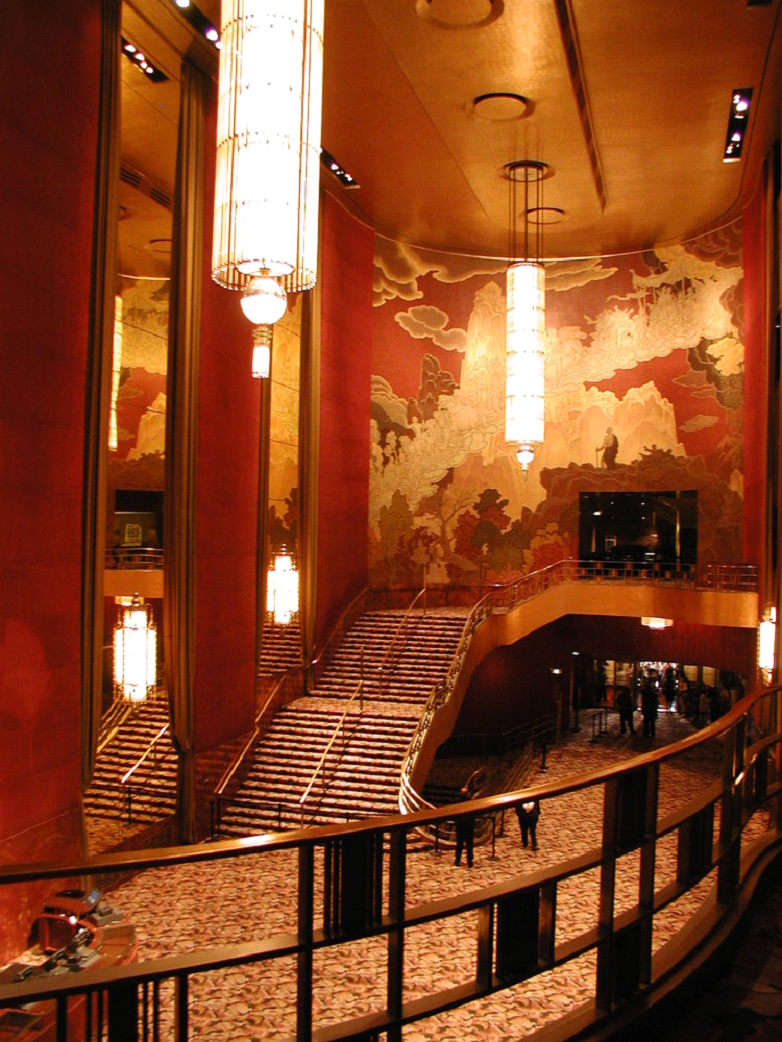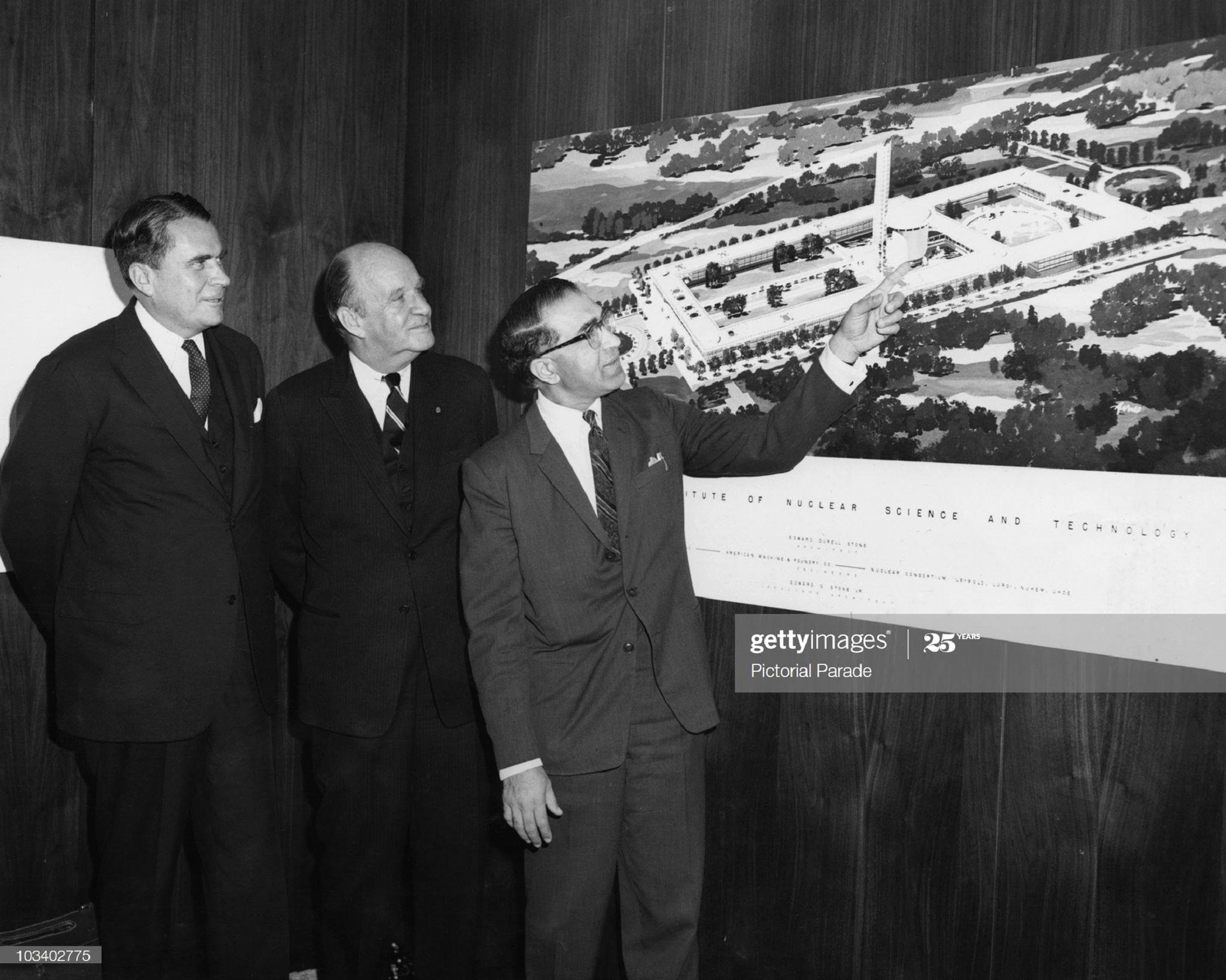Edward Durrell Stone: Modernism’s Maverick

- Edward Durrell Stone's architectural evolution transitioned from the stark, minimalist International Style to a more decorative and regionally inspired modernism, reflecting a response to public preferences and cultural contexts.
- Stone's work, particularly his design of 2 Columbus Circle (the "Lollipop Building"), sparked significant controversy, highlighting the tension between modernist ideals and decorative elements in architecture.
- Despite criticism, Stone's global influence, especially his projects in India and Pakistan, demonstrated his ability to integrate modernism with local traditions, making him a pivotal figure in mid-20th-century architecture.
Modernism in the early part of the 20th century emerged through an explosion of ideas that stripped architecture and design of irrelevant decoration, exploiting materials such as concrete, glass, and steel—largely due to the deprivation left by World War I. From the sculpted forms of the expressionist style of the past to the new age functionalism of concrete and glass buildings, architects developed the International Style. While the International Style was chosen to describe the modernist architecture of the 1920s and early 1930s, influenced by architects such as Mies van der Rohe, Walter Gropius, and Le Corbusier, one architect infamous for pursuing this style was Edward Durrell Stone (1902-1978). An American architect, educator, and designer, Stone was an early practitioner of the International Style but took his architecture in a different direction after the post-war 1940s. By 1958, Stone, who designed buildings across all borders, was the best-known architect in the world.
Working globally, Stone considered not only the structure but also the various factors affecting it as a whole. His design for the U.S. Embassy in India brought modernism while balancing the cultural aspects of the nation. His travels around the world and studies in climate change informed his understanding of India’s tropical climate, enabling him to deliver a climate-responsive structure.
When critically examining his works as a modernist pioneer, Stone came under significant controversy as his stylistic progression increasingly fell out of favor due to his shift from the International Style to a more “romantic” modern aesthetic that incorporated decoration along with aspects of monumentality, regionalism (the importance of vernacularity), historicism, and fantasy. Stone’s first phase of work began in the mid-1930s when he experimented with the International Style after it was presented in 1932 at the Museum of Modern Art (founded in 1929) in New York City. Following the fanfare of neoclassicism’s influence in the 1920s, Stone’s early work also contained hints of opulence.

The Radio City Music Hall in Manhattan, completed in 1932, was a collaboration with Donald Deskey, designing the interiors of one of the main halls. Following the preconceived notion that opera halls should feel grand, we see Stone’s experimentation with modernist style through minor details. From light fixtures to clean metal hand railings, he breaks away from ornamental grandeur, introducing sleek cylindrical forms as chandeliers. However, the additional beautification of the hall is still present through painting-esque wallpapers, albeit in subtle colors.
Continuing with his International Style experimentation, Stone gained a reputation as a great designer of contemporary residential architecture. The Richard H. Mandel House in New York (1934) and the A. Conger Goodyear House in New York (1938) both allowed Stone full freedom. “Mr. Stone embodied principles of European modernism. He worked with steel, concrete, and plate glass. He created great open spaces, so that one room in the house flowed into the other.” These specific sites allow us to observe how Stone understood the relationship between the site and its built structure.
Soon, Stone realized that the general public found the strict contemporary vocabulary “too sparse, too arid, too cold.” Fully aware, he shifted to an American vernacular expression advised by Frank Lloyd Wright, who became not only an inspiration but a mentor. This shift can be seen in the Walter and Betsy Johnson Home in Connecticut, completed in 1953. Another project with a green site, this home demonstrates the relationship Stone formed between the built structure and its environment, using wood for both the exterior and interior. By designing this house, Stone managed to satisfy both societal expectations and his clients’ needs without compromising his standards. He fused vernacular style with his modern ideologies.

While receiving much appreciation for his ideas and designs, Stone also garnered significant criticism. One of these infamous structures is the 2 Columbus Circle, or “The Lollipop Building,” in Manhattan, built on an irregular site and formerly known as the Gallery of Modern Art. The 10-story concrete modern-style building, with a touch of ornamentation, has been the height of controversy since the 1960s. Famously described as “a die-cut Venetian palazzo on lollipops” by architecture critic Ada Louise Huxtable, the building remains a point of contention.
However, despite the criticism, Stone was highly envied by his peers for receiving countless projects locally in America and being commissioned to design some of the most sought-after projects of the time. Notable among these were the American Embassy in New Delhi, India, and the United States Pavilion at the World’s Exposition in Brussels, Belgium, in 1958. Working globally, Stone considered not only the structure but also the various factors affecting it as a whole. His design for the U.S. Embassy in India brought modernism while balancing the cultural aspects of the nation. His travels around the world and studies in climate change informed his understanding of India’s tropical climate, enabling him to deliver a climate-responsive structure. The exterior jaali, or latticed screen facade, kept traditional Indian architecture alive, while the grand entry and double-height glass facade introduced Stone’s modernist touch.

Stone was also a luminary in Pakistan’s architecture in the 1960s, working on projects such as the Pakistan Institute of Nuclear Science and Technology, Pakistan International Airlines office buildings and mosques, the Water and Power Development Authority in Lahore, and the Presidential Palace for General Ayub Khan. One of the main reasons for his numerous commissions was Stone’s seamless understanding of how to implement Islamic design in his site plans. He utilized ornamental, religious patterning and detailed materials to resemble historic Islamic architecture.
Lastly, Stone is still remembered as “a controversial architect about whose work architects and other people seem to have widely divergent views.” Ironically, Stone himself acknowledged that “a great building should be universal, not controversial.” Whatever the opinions may be, Edward Durrell Stone was a point of criticism during his time, as he understood the potential for future living that embodied modern architecture and new materials.
The views and opinions expressed in this article/paper are the author’s own and do not necessarily reflect the editorial position of The Spine Times.

Maheen Inkasar Khan
The author is a 5th Year Architecture student at the Institute for Art and Culture (IAC), Lahore, with a passion for exploring and critically analyzing various dimensions of art, architecture, and films.






Brilliant Brilliant Brilliant piece! So detailed! Love the effort the author put in!
stone was lowkey a tiktok star, he knew things needed to constantly change & adapt to stay relevant. he didn’t just follow trends, he mixed things up, adding his own flare to it & made modernism more relatable for everyone, super ahead of his time!! this is a reminder that we constantly need to evolve ourselves, no matter what criticism we have face along the way.
you really made his work come alive again Maheen!! keep building ur legacy, super proud of u!!!!!!!!!!
Excellent read.
BaddieHub This was beautiful Admin. Thank you for your reflections.
Great insight and great writeup 😊👍🏻
Specialized Pipes in Iraq At Elite Pipe Factory in Iraq, we pride ourselves on offering a diverse range of specialized pipes to meet various industrial and scientific needs. Our glass pipes, ideal for laboratory settings, are manufactured with the utmost precision to ensure clarity and durability. These pipes are perfect for handling and observing chemical reactions under controlled conditions. Elite Pipe Factory is renowned for its quality and reliability, setting the standard for glass pipe production in Iraq. For more information, visit our website: elitepipeiraq.com.
Ведущее digital агентство: размещение рекламы в Интернете (контекстная, медийная, таргетированная, нативная реклама, видеореклама), веб-разработка.
seo студия
продвижение сайтов в гугл
На сайте https://footbal.net.ua/ почитайте информацию, касающуюся новинок футбола. Вы узнаете всю интересную, актуальную и содержательную информацию на данную тему. Рассказывается и про команды, то, какие победы они одержали и многое другое. Здесь публикуется вся свежая, новая, интересная информация, которая обязательно вам пригодится, если являетесь фанатом такого вида спорта. Здесь имеются различные прогнозы, результаты матчей. Все интересные сюжеты сопровождаются картинками, видеоматериалами.
мтс подключение
https://luxuriousrentz.com/%d0%ba%d0%b0%d0%ba-%d0%bf%d0%be%d0%b4%d0%ba%d0%bb%d1%8e%d1%87%d0%b8%d1%82%d1%8c-%d0%bc%d0%be%d0%b1%d0%b8%d0%bb%d1%8c%d0%bd%d1%83%d1%8e-%d1%81%d0%b2%d1%8f%d0%b7%d1%8c-%d0%bc%d1%82%d1%81/
мтс цены
На https://professionals.beauty вы найдете информацию о салонах красоты, их услугах, мастерах и контактных данных. Если вы владелец салона, вы можете зарегистрировать свой салон и привлечь новых клиентов. Платформа предоставляет возможность размещения вакансий для мастеров и салонов. Если вы ищете работу или хотите найти нового специалиста, это отличное место для поиска. Мастера могут учиться и повышать свою квалификацию через онлайн-курсы и мастер-классы. Это поможет им развиваться и оставаться в тренде.
Онлайн-слот Dinopolis перенесет вас в Лас-Вегас, где правят древние ящеры. Если на вашей стороне будет удача, вы большие призы сможете выиграть. Игра на генераторе случайных чисел основана, она лицензирована. Вы сможете на выигрыш шансы увеличить, если воспользуйтесь бонусами и промо кодами. https://dinopolisgame.com/ru/– портал, где вы узнаете плюсы и минусы слота, ознакомитесь с ответами на вопросы и узнаете реальные отзывы от профессионалов. Наслаждайтесь игрой. Удачи вам!
Консультация юриста наследство самоубийцы – это важный и зачастую деликатный вопрос, требующий особого внимания к юридическим нюансам. В случае, если наследодатель принял решение о прекращении своей жизни, это может создавать сложности в вопросах наследования, поскольку в некоторых юрисдикциях существуют правила, которые ограничивают права наследников, если они были причастны к самоубийству или пытались причинить вред покойному. Консультация юриста наследство самоубийцы поможет вам разобраться в специфических аспектах данной ситуации, оценив возможные юридические последствия для оставшихся в живых наследников. Специалист в области наследственного права сможет предложить необходимую правовую поддержку и поможет избежать потенциальных конфликтов, которые могут возникнуть между наследниками. К тому же, важно понимать, какие документы потребуется собрать и какие сроки следует учитывать, чтобы защитить свои интересы. Консультация юриста наследство самоубийцы также позволит вам получить советы по проведению процесса раздела имущества и уточнению прав на долю в наследстве. Профессиональная помощь в этой непростой ситуации существенно облегчит процесс получения наследства и обеспечит юридическую защиту ваших прав как наследника.
Рекомендую обратиться за консультацией к юристу по наследству , чтобы получить профессиональное сопровождение и защитить свои интересы.
На сайте https://kinoteatr-ru.top/ вы найдете большой выбор самых интересных, увлекательных и необычных фильмов от проверенных создателей. Все кино отличается качественной картинкой, объемным звуком, а потому точно понравится всем киноманам. Регулярно происходит обновление сериалов, фильмов, чтобы вы смогли посмотреть то, выхода чего вы ожидали долгое время. На сайте есть как классические решения, так и современные новые фильмы, которые точно не оставят вас равнодушным. Смотрите фильмы с любого устройства: планшета или смартфона, ПК.
Jednou z výhod, kterou nabízí plechová krytina falcovaná, je její dlouhá životnost a moderní vzhled.
Jednou z výhod, kterou nabízí plechová krytina falcovaná, je její dlouhá životnost a moderní vzhled.
На сайте https://kusky.ru/ вы узнаете про тренды в строительстве. Есть информация про то, как осуществить расчет нагрузки на стальную балку. Представлены материалы и на другую тему, включая расчеты. Например, про то, сколько арматуры вам потребуется на бетонную плиту. Если предстоит выполнение каких-либо работ, но не знаете, как произвести расчеты, то в этом случае необходимо воспользоваться данным сайтом, на котором вы найдете ответы на любые вопросы в плане строительства. Здесь представлено огромное количество информации, а новые сведения добавляются регулярно.
Цветы свежие, как будто только что срезали.
цветы томск
Strips, profiles and seals for 365eventcyprus.com sealing rooms or spaces in devices and equipment.
There are no universal plants that newmexicodesign.net can be used in all situations. The application is affected by the type of soil, its acidity, and moisture regime. The most universal options are legumes. They can be sown in light and dense soils, loosening and increasing the nitrogen content naturally. The effect of application is comparable to the introduction of manure.
In addition to being apartusa365.com placed on a door or a shop window, these stickers can be used to install on car windows or other objects.
miamicottages.com
texasnews365.com
cottageindesign.com
Заказала пионы на день рождения, все гости были в восторге!
пионы купить в Томске
Hydrophilic green manures repaircanada.net are used to combat weeds and harmful microflora. These crops are used on acidic soils, reducing this indicator.
texasnewsjobs.com
There is a photo of the car alanews24.com with the main technical parameters, the cost of daily rental and two-week use.
Skin should be covered texas-news.com with thick fabric as much as possible, a respirator and protective glasses will protect the respiratory system and vision.
It is possible to manufacture alabama-news.com any batch of silicone products according to the customer’s drawings and projects.
Benefits of Using Green Manure elitecolumbia.com for Topdressing: What You Need to Know
nebrdecor.com